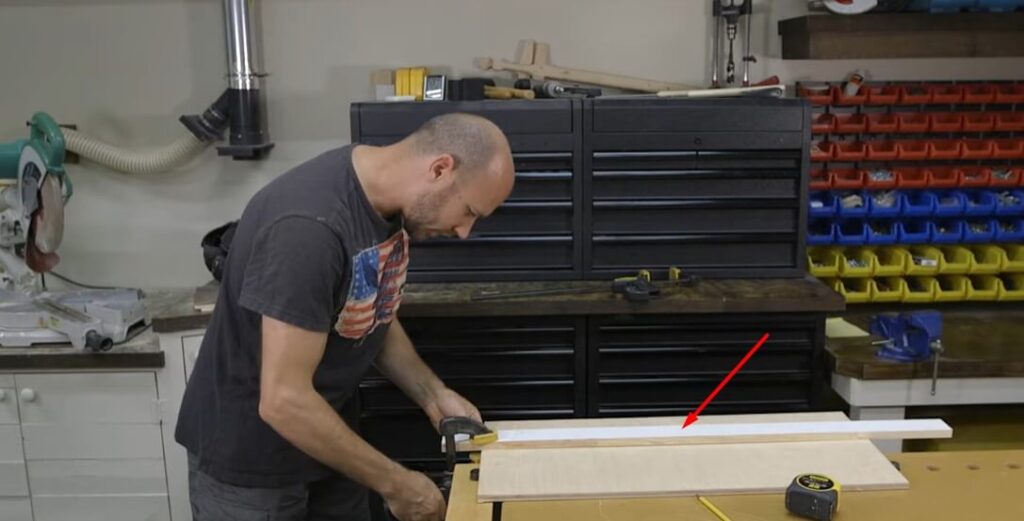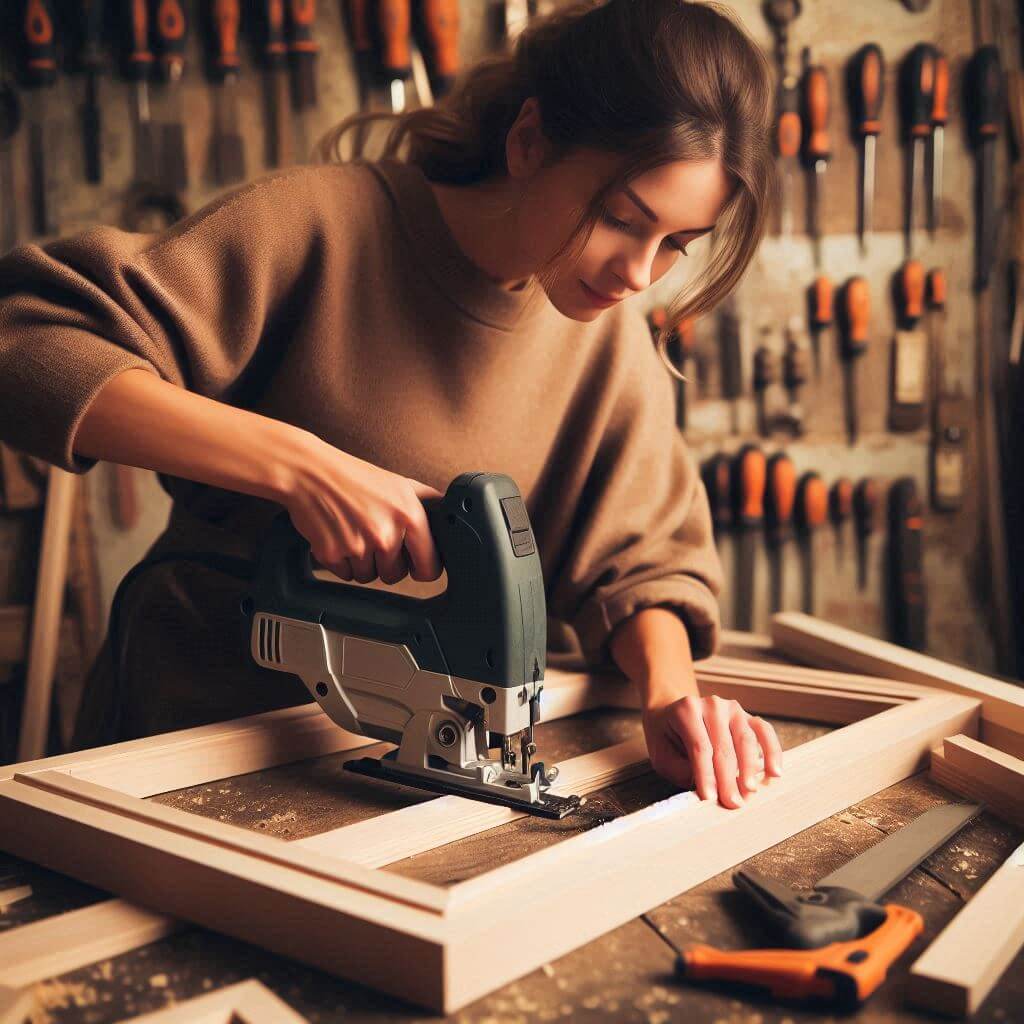Have you ever tried to cut a straight line with a jigsaw and found it tricky? Don’t worry, because today we’re going to learn how to do it perfectly. Cutting a straight line is not only fun but also super important for making cool things like birdhouses, picture frames, and even toys.
Are you ready?
To cut a straight line with a jigsaw, clamp a straight edge to your workpiece and guide the jigsaw along it. This will ensure a straight and accurate cut.
Sit tight! In this article, we will discuss some tips on how to cut straight lines with a jigsaw and ensure that your cuts are accurate and precise. We will also provide you with information on what type of jigsaw blade to use and some common mistakes to avoid while cutting straight lines with a jigsaw.
So, Let’s get started! 🎉

Meet the Jigsaw!
Imagine a jigsaw as a really cool electric saw that moves up and down really fast. It’s like a super-fast pair of tiny scissors. It helps you cut wood, plastic, and even metal into any shape you want. But today, we’re focusing on making nice, straight lines.
Safety First!
Dress Up for Safety
Before we jump into cutting, we need to dress up like superheroes. Why? Because safety is our superpower! Put on your safety goggles to protect your eyes, and wear gloves to keep your hands safe. Don’t forget to tie back any long hair and wear closed shoes. Now you’re ready! 👍
Check Your Tools
Make sure your jigsaw is in good shape. Check if the blade is sharp and tight. A dull or loose blade can make your cuts wobbly. Also, ensure the jigsaw cord is not damaged. Safety check, done!
Choose The Right Blade For Straight Cuts
Not all blades are the same. For straight cuts, you need a fine-toothed blade. These blades make smooth cuts and are easier to control. It’s like choosing the right crayon for coloring within the lines. 🎨
Here are some tips on selecting the appropriate blade for the material being cut and achieving a straight line.
How Jigsaw Blades Can Affect the Straightness and Precision of The Cut?
Choosing the right jigsaw blade is crucial for achieving a straight line cut. Here are three factors to consider when selecting a jigsaw blade:
- The type of blade: The blade’s design and material can impact the quality of the cut. Choose a blade with a t-shank design for a quality straight cut. The blade’s teeth have a cross-ground design and are sharp enough to cut straight through wood, plastics, and other materials.
- Blade length: The blade length can make a significant difference in how straight the cut will be. Longer blades can provide more leverage and stability, enabling the tool to make cleaner cuts. Shorter blades are, however, easier to control and navigate curves and tight corners.
- TPI (Teeth Per Inch): The TPI measurement indicates how tightly the teeth are packed together. The higher the TPI, the smoother the cut will be. A low TPI blade is better suited for cutting thicker materials, while a higher TPI is perfect for thinner materials.
Types Of Blades for The Material Being Cut
Choosing the right blade for the material being cut is also crucial. Here are some materials and the ideal blade to use:
- Wood: A high-carbon steel blade that is made specifically for cutting wood is ideal. It is durable and can handle years of cutting.
- Metal: Blades made from bi-metal are suitable for cutting through metal as they are exceptionally resilient and can handle prolonged use.
- Plastic: Plastic-cutting blades are designed with teeth that have a special set and design that ensures a clean cut.
Tips On Choosing the Right Blade
The thickness of the material being cut also plays a significant role in the type of blade that should be used. Here are a few points to consider:
- Thin materials: Use a blade with a high TPI count, as it provides a cleaner cut. A 20–24 TPI is perfect for cuts that are less than 3 mm.
- Medium materials: Materials that are ¼ inch to 1 inch thick are best cut with TPI counts between 10 and 14. A blade that is 4 inches long works well with this group of materials.
- Thick materials: Use a blade with a low TPI count when cutting materials with a thickness of more than 1 inch. A TPI count of 6 to 8 is best suited for thick, dense materials.
Choosing the right blade for your jigsaw is a crucial step towards achieving a straight cut. Take the time to study the material you will cut and how thick it is before selecting a blade. This way, you can be sure you have the right tool for the job and get the best results.
Preparing Your Work Area
Clear the Space
Find a clean, clutter-free area to work. Remove anything that might get in your way. Imagine you’re clearing your play area before starting a fun game.
A Stable Surface is Key
Make sure your workpiece (the thing you’re cutting) is on a stable surface. If it moves, your line might not stay straight. You can use clamps to hold it down. Think of it like keeping your paper still while you draw.
Marking the Straight Line
Whether you’re a DIY enthusiast or an experienced woodworker, it’s essential to take accurate measurements while cutting any material. Doing so ensures precision and reduces the chances of mistakes, making the process quicker and more efficient.
Here are some tips for taking accurate measurements for cuts.
Grab a Pencil and Ruler
Draw a straight line where you want to cut. Use a ruler to keep it straight. Drawing the line is like making a path for your jigsaw to follow. Make it bold and clear.
Here are some things to consider when using a straight edge:
- Use a straight edge that has a secure grip, so it doesn’t move out of place while you’re cutting.
- Clamp the straight edge or ruler to the material properly.
- Use a ruler that has clear markings for easy reading and understanding.
- Make sure the cutting line is visible. Use a sharpened pencil, brightly colored chalk, or masking tape for visibility.
- Use a T-square or a set square to create a 90-degree angle with the straight edge for perpendicular cuts.
- Consider using a laser level for marking the cutting line on a large piece of material.
- Double-check your measurements before cutting to avoid mistakes.
By using a straight edge or ruler, marking out the cutting line correctly, and ensuring the line is visible, you can make precise cuts without irregularities every time. Taking care with measurements might seem like a time-consuming task, but in the long run, it saves a lot of effort and frustration.
Setting Up The Jigsaw
Before cutting a straight line with a jigsaw, it is crucial to set up the tool properly. Here’s how:
- Choose the right blade: The type of blade you use depends on the material you’re cutting. For example, use a wood blade for cutting wood and a metal blade for cutting metal.
- Check the angle of the blade: The angle of the blade can affect the straightness of the cut. Make sure that the blade is perpendicular to the base plate to ensure a straight cut.
- Adjust the base plate: To ensure an even and parallel blade to the cutting surface, adjust the base plate. Do this by loosening the screws that connect the base plate to the jigsaw and then reposition the plate until it is parallel to the blade.
- Secure the blade: Once the blade is in place, make sure that it is securely tightened. A wobbly blade can cause uneven cuts, leading to crooked lines.
- Plug it in and Get Ready: Plug in your jigsaw and make sure it’s working. Hold it firmly but comfortably. Place the jigsaw’s base flat against the workpiece, with the blade just touching the start of your line.
Using these proper setup techniques and taking time to ensure everything is properly aligned will help you achieve the straight cut you’re after.
Starting Your Cut
If you have a jigsaw, you may assume it’s only suitable for cutting curved lines. However, with a few guidelines and some practice, you can also cut a straight line with a jigsaw. Here’s a detailed explanation of how to do just that.
Proper Positioning of The Jigsaw When Starting a Cut
To ensure a straight cut, position the jigsaw blade perpendicular to the cutting material before you begin. Make sure the blade is aligned with the cutting line and gently lower the blade onto the material. Hold the jigsaw handle firmly but avoid applying too much pressure, as it may cause the blade to veer off course.
If you need to turn the jigsaw’s blade to align it with the cutting line, make sure you lock the blade in place before lowering it onto the material.
Slow and Steady Wins the Race
Press the trigger gently to start the jigsaw. Begin cutting slowly along the line. Going too fast can make the blade wander off the line. It’s like trying to color too quickly – you might go outside the lines.
Here are some recommendations for grip, speed, and angle during the cutting process:
- Grip: Hold the jigsaw’s handle with both hands, positioning your dominant hand behind the jigsaw and the other hand near the base. Avoid holding the jigsaw too tightly, as it may cause your cuts to veer off course.
- Speed: To ensure a straight and smooth cut, use a moderate speed while cutting. If you move too quickly, you may end up with a jagged or crooked cut.
- Angle: Keep the jigsaw blade perpendicular to the cutting material throughout the entire cut. Avoid tilting the blade to either side, as it may cause the blade to wander off the cutting line.
Keep Your Eyes on the Line
As you cut, keep your eyes on the line you drew. Use both hands to guide the jigsaw smoothly. It’s like following a treasure map. Stay on the path to find the treasure – a perfect straight cut!
If you notice the blade beginning to veer off course, gently maneuver it back onto the cutting line.
Finishing the Cut
Turn off and check your work. When you reach the end of the line, turn off the jigsaw and let the blade stop completely. Lift the jigsaw off the workpiece and admire your straight cut. You did it! 🎉
Mistakes to Avoid When Cutting with a Jigsaw
When it comes to cutting straight lines with a jigsaw, it’s easy to make mistakes, especially if you’re new to using a jigsaw. But don’t let that stop you from using this versatile tool. With a bit of patience, precision, and planning, you can cut a perfectly straight line with a jigsaw every time.
Common Mistakes To Avoid When Cutting with a Jigsaw
Before we dive into the specific mistakes, it’s essential to highlight the importance of setting up your workspace correctly to ensure a smooth and successful cutting process. Here are some essential tips to set up your workspace before cutting with a jigsaw:
- Secure your workpiece with clamps or a vice to prevent movement while cutting.
- Make sure the saw blade is sharp to cut through the material more efficiently.
- Adjust the speed of the saw to your specific material and the type of blade you’re using.
- Wear protective gear, such as safety glasses and earplugs, to protect yourself from flying debris and loud noise.
Now, let’s go over the most common mistakes people make when cutting with a jigsaw and how to avoid them:
Wavy Lines
If your cut is wavy, don’t worry. Practice keeping a steady hand and moving slowly. You can also use a guide to help you stay straight.
Splintered Edges
If the edges are splintered, try using a finer blade or placing masking tape over the line before cutting. It helps keep the wood from tearing.
Applying Too Much Pressure
It can be tempting to push down on the jigsaw to cut through the material faster, but this technique will likely result in a rough, jagged line. The key to cutting straight with a jigsaw is to apply just enough pressure to guide the saw, but not so much that it causes the blade to bend.
To avoid this mistake, let the saw do the work. Apply gentle pressure to guide the saw but let it do most of the cutting.
Advanced Tips and Tricks
Using a Guide
A guide is like training wheels for your jigsaw. You can use a piece of wood or a metal ruler to help keep the jigsaw on track. Clamp it down along your line and cut alongside it.

Different Blades for Different Jobs
Explore different blades for different materials and cuts. Some blades are better for curves, and others are better for thick materials. Knowing which blade to use makes your work easier and more fun.
Craft Projects to Try
Build a Birdhouse
Now that you’re a jigsaw master, try building a birdhouse. It’s a fun project that uses straight cuts and lets you create a cozy home for birds.

Create a Picture Frame
Make a picture frame to display your favorite photo. It’s a simple project that’s great for practicing straight cuts and making something beautiful.

FAQs: How to Cut a Straight Line with a Jigsaw?
How Do I Cut a Straight Line with a Jigsaw?
To cut a straight line with a jigsaw, follow these steps: clamp the wood, mark the line, use a guide, and cut slowly.
What Blade Should I Use for Cutting Straight Lines with a Jigsaw?
For cutting straight lines with a jigsaw, use a fine-toothed blade with a high TPI count.
How Do I Avoid Splintering When Cutting with a Jigsaw?
To avoid splintering when cutting with a jigsaw, tape the cutting line, support the wood, and start cutting from the backside.
Can I Use a Jigsaw to Cut Metal?
Yes, you can use a jigsaw to cut metal. However, you need to use the right blade and cutting oil to prevent damage to the tool.
How Do I Maintain My Jigsaw for Optimal Performance?
To maintain your jigsaw for optimal performance, keep the blade sharp, lubricate the blade guide, and avoid forcing the tool during the cut.
Conclusion: You’re a Jigsaw Master!
Wow, look at you! You’ve learned how to cut a straight line with a jigsaw like a pro. Remember, the key is to take your time, be safe, and have fun. Now go out there and create amazing things with your new jigsaw skills. Happy cutting! 😊
Recent Posts
Woodworking in 2025 is all about efficiency, precision, and smart technology. Whether you're a beginner or a seasoned craftsman, having the right tools can make all the difference. Here are the top 7...
Ever tried drilling into a piece of wood only to end up with a splintered mess or a wobbly hole? Yeah, it's more common than you think. Wood might seem like an easy material to work with, but...

